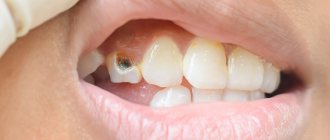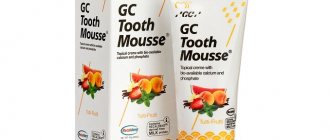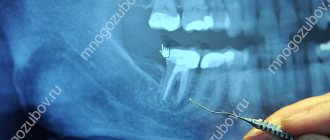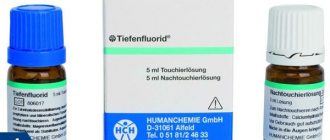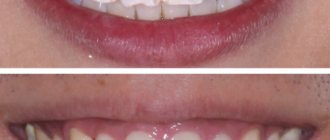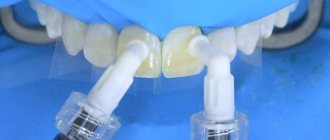If your teeth have lost their shine, then you may be experiencing enamel demineralization. With demineralization, teeth lose mineral components. This is a reversible process, but if it proceeds too quickly and the enamel does not have time to recover naturally, the teeth become fragile and hypersensitive, stains and cracks appear on them, and caries develops.
This problem occurs especially often in children. Those with a sweet tooth and lovers of carbonated drinks are also at risk. In this article we will talk about the causes of enamel demineralization, the consequences of this pathology, and also consider ways to prevent and treat it.
What is dental demineralization
The hardness of tooth enamel is ensured by the content of inorganic substances in it.
It is mainly hydroxyapatite, consisting of calcium and phosphate atoms. Fluoride also adds strength to enamel, protecting it from the harmful effects of acids and microbes. Demineralization refers to the loss of minerals from the enamel. This process causes teeth to become dull and brittle. The enamel becomes thinner and becomes sensitive. Hyperesthesia develops - increased sensitivity of teeth to hot, cold or sour foods. In addition, loss of minerals increases the risk of developing tooth decay. Such teeth become easy prey for bacteria.
When is remineralization prescribed?
A set of restorative procedures is necessary if caries often appears, if the enamel reacts to cold or hot, sour and sweet, with pathological abrasion of teeth, metabolic disorders in the body, and also after orthodontic treatment. In addition, teeth become sensitive in adolescents during puberty and in expectant mothers during pregnancy.
Symptoms of dental demineralization
The main symptoms of demineralization include:
- loss of wet shine in enamel;
- roughness on the surfaces of teeth;
- the appearance of dull spots on the teeth;
- coloring matte spots with food pigments or dyes;
- fragility (porosity) of enamel.
Demineralization in an adult: photo
Causes of tooth demineralization
The main mechanism for the occurrence of pathology lies in the action of acids. In this case, the destructive process occurs according to 2 scenarios:
- under the influence of acids from the outside;
- when acids form in the oral cavity.
In the first case, when a person consumes a lot of acidic foods or drinks (for example, fruit juices, vinegar), the surface layer of enamel becomes thinner over the entire area of the tooth. In the case of acids formed by cariogenic bacteria in the oral cavity, subsurface demineralization of individual lesions/spots occurs. Therefore, focal demineralization in children and adults is a clear sign of the onset of caries.
Among the factors contributing to demineralization are:
- Poor oral hygiene is a major factor contributing to mineral loss.
- Excessive passion for carbohydrate foods - sweets, sweet sodas, juices, flour products. Bacteria process carbohydrates, forming organic acids - lactic, pyruvic, acetic, malic and others.
- Presence of dental diseases.
- Wearing dentures and other orthodontic structures.
- Malocclusion and other dental problems.
- Hormonal changes that contribute to the leaching of minerals from teeth and bones. Most often this concerns women during pregnancy and menopause.
- Metabolic diseases, such as diabetes.
- Diseases of the gastrointestinal tract that impair the absorption of nutrients, in particular minerals.
- Helminthic diseases, in which a significant part of the nutrients and microelements is consumed by parasites.
- Bad habits – smoking, alcohol abuse.
Important: fresh juices . Many people mistakenly believe that there is no harm from fresh juices, because they are a natural drink full of vitamins. However, it is not. Fresh juices contain a lot of sugar. For example, to prepare a glass of apple juice you need to take 3-5 apples. In addition, such juices contain a lot of fruit acids, which is harmful to the enamel.
Main reasons
First of all, it is worth highlighting the main factors that cause the process of increased loss of important minerals contained in the enamel structure:
- the presence of carious organisms in the oral cavity;
- the presence of residues from carbohydrate foods.
Attention! Due to the fact that there are a large number of bacteria or carbohydrate foods in the oral cavity, there is a decrease in the acid-base balance. As a result, the remineralization process is disrupted, which ultimately causes destruction of the enamel structure.
In addition to the main reasons, there are additional factors that lead to demineralization:
- Failure to maintain adequate oral hygiene;
- The presence of inflammatory processes of the gums;
- Pathological processes in the adrenal glands and thyroid gland;
- Diabetes;
- A disorder or complete change in hormonal levels;
- The use of orthodontic devices;
- Demineralization may occur when teeth are crowded;
- Eating large amounts of fast carbohydrates.
All of the above factors can also quickly provoke the process of demineralization; they lead to the leaching of mineral salts from tooth enamel, and also provoke an active process of destruction of dental tissue. For this reason, you should carefully monitor your health. If any of the above factors are detected, you should immediately consult a doctor.
Diagnosis of the disease
Diagnosis of suspected demineralization comes down to the following procedures:
- Inspection . The doctor cleans the teeth of plaque and dries them. The presence of white matte spots on the teeth indicates pathology.
- Enamel staining . The doctor stains the cleaned and dried teeth with blue dye. Unlike healthy areas, areas of demineralization are stained. Moreover, the brighter the shade, the more serious the damage to the enamel.
- Application of ultraviolet light . When teeth are illuminated with ultraviolet light, healthy areas glow blue, while damaged areas glow dark.
- Using a laser . The method is based on the fact that areas with different mineralization reflect laser waves of different lengths.
Demineralization of baby teeth in children
Demineralization of teeth is a common occurrence among children. Two factors are decisive here - poor oral hygiene and a passion for sweets.
As a rule, in children and adolescents, demineralization takes the form of irregularly shaped spots. The color of such formations varies from white to brown. Most often, the pathological process in a child begins in the cervical area, then spreading to other areas.
Important. If demineralization spots have acquired a brown color, this indicates an advanced process. In this case, not only the enamel is affected, but also the dentin tissue.
Demineralization of teeth in a child: photo
Signs of demineralization
The lack of minerals appears gradually. At first, the crowns simply become matte. The beautiful pearly shine that characterizes a healthy smile disappears.
Then more noticeable defects are added:
- the enamel becomes rough;
- white chalky spots appear;
- light spots darken and turn brown;
- the enamel takes on a “porous” appearance.
All this “beauty” most often appears between the teeth - on the side surfaces of the crowns, at the edge of the gums, on the fissures - the chewing grooves of the tooth. To see the first signs of demineralization, just look at your smile in the mirror. And it would be better to notice the problem right away, because at the stage of brown spots, others will notice it.
Demineralized tooth in section
How to reduce demineralization
You can pause the pathological process (and even reverse it) by following some recommendations:
- Nutrition . Eat foods that contain calcium, phosphorus, vitamin D and fluoride. These are milk and dairy products, fish, meat, legumes, grains, as well as broccoli and eggs. Limit your intake of carbohydrate-rich foods, especially sweets, sugary sodas and juices.
- Ultraviolet . Walk outdoors in sunny weather. Sunlight is necessary for the formation of vitamin D.
- Hygiene . Brush your teeth 2 times a day. If you have a fluoride deficiency, then toothpastes with fluoride will be useful. This element strengthens tooth enamel.
Important: fluorosis . Fluoride is one of the key elements needed to maintain enamel strength. However, an excess of fluoride is no less harmful than its deficiency. When there is too much fluoride, fluorosis develops. This pathology often occurs in regions with high levels of fluoride in drinking water.
Remineralization and fluoridation of tooth enamel
Remineralization and fluoridation of tooth enamel
Shiny and hard tooth enamel serves as decoration and reliable protection for dental tissue from mechanical, chemical and bacterial damaging factors. The strength of this thin layer is ensured by the presence of calcium, phosphorus, fluorine, magnesium, sodium, potassium, chlorine and some other inorganic ions in its crystal lattice.
Demineralization of tooth enamel, its causes and consequences
As a result of prolonged exposure of enamel to an overly acidic or alkaline environment, some minerals may be washed out. This process is called demineralization and leads to a change in the composition and deterioration of the protective properties of tooth enamel. A particularly negative impact on the degree of its strength is exerted by the lack of fluorine and some inorganic compounds (apatites, carbonates and others), which serve as the basis for calcium hydroxyapatite. As a result of the lack of this component, favorable conditions arise for the appearance of chalky stains on the surface of the teeth - the primary stage of caries. Timely replenishment of missing mineral components (remineralization) helps stop the development of carious lesions of tooth enamel and even restore its original appearance. In conditions of healthy oral microflora and normal saliva composition, the natural processes of demineralization and remineralization occur constantly and ensure a balanced mineral balance of tooth enamel. But in the modern realities of urban life it is very difficult to create favorable conditions for this. Especially with low quality drinking water, poor diet, inadequate daily menu, consumption of large amounts of sweets, canned, refined foods, etc. Therefore, if there are the first signs of demineralization of tooth enamel (increased tooth sensitivity, the appearance of white spots, etc.), in order to prevent or treat associated diseases, it is imperative and most importantly to consult a dentist in a timely manner. To maintain healthy microflora in the oral cavity, in addition to teeth, it is also necessary to regularly and properly brush your tongue. Moreover, interdental spaces that are inaccessible to a regular toothbrush can be cleaned using, for example, a floss - a tool like a toothpick with floss.
Remineralizing therapy
Remineralization of tooth enamel
is a dental procedure for restoring the disturbed balance of the mineral components of the crystal lattice of tooth enamel to increase its strength, protect against external damaging factors and prevent diseases of the teeth and gums. Indications for remineralization therapy are the following factors: • increased degree of tooth sensitivity; • carrying out some whitening procedures, for example, laser whitening; • as part of complex therapy during orthodontic and orthopedic treatment; • initial stages of caries: the first - the primary chalk spot and the second - superficial destruction of the enamel; • various non-carious congenital and acquired diseases and pathologies: enamel hypoplasia, softening of dental bone tissue, erosive damage, increased abrasion of enamel, wedge-shaped defect, demineralization and necrotic lesions of tissue under tartar, etc.
The first and main source for the natural replenishment of tooth enamel with missing mineral components is saliva. The second delivery route is the penetration of ions of inorganic elements into the enamel from the internal pulp through the dentin of the tooth. But in percentage terms, this method of transporting minerals is less significant. Therefore, the basis for various methods of remineralization therapy was the first, external option for the delivery of macro and microelements to the hard tissues of tooth enamel.
There are two main methods of local remineralization of tooth enamel:
1. External treatment of the surface of teeth with mineralizing solutions, which are applied to the enamel in the form of applications. 2. Delivery of ions of mineral components inside tooth enamel through the use of physiotherapeutic devices for electrophoresis and phonophoresis.
The procedure for conducting a course of remineralizing therapy consists of alternately applying special mixtures, which contain the mineral components necessary to strengthen and increase the resistance of enamel: ionized fluorides, calcium, phosphorus, zinc, strontium and some others.
The drugs for remineralization include: 10% calcium gluconate or calcium chloride, 0.2% sodium fluoride, 5-10% calcium phosphate (acidified solution), 2.5 calcium glycerophosphate, complex preparation “Remodent”, “Ftorodent”, “GC” Tooth Mouss" and others.
Before starting remineralization procedures using the application method, the teeth are thoroughly cleaned of plaque and dried. Then, tampons soaked in a 10% calcium gluconate solution are applied to the tooth enamel for 15 minutes (if they dry out, they need to be replaced with new ones every five minutes). After this, a tampon with a 0.2% sodium fluoride solution is applied for 3 minutes.
Thus, alternating local applications from various solutions, the enamel is saturated with these mineral components. In this case, conditions arise for the formation of a very durable layer of fluoroapatite compounds on it.
The entire course of remineralization therapy lasts from 5 to 20 days. Sessions can be held daily or every other day. With physiotherapeutic retherapy methods, the entire course can consist of 10–15 procedures. At the end of the course of treatment, a special protective fluoride-containing varnish is applied to the surface of the teeth.
Teeth strengthening procedures are often prescribed before whitening. Even if you decide to whiten your teeth at home, you need to think about possible damage to the enamel and visit a dentist.
Strengthening tooth enamel with fluoridation
Fluoridation of tooth enamel
is one of the methods of remineralizing therapy to strengthen tooth enamel and increase its resistance to aggressive acidic environments. Saturation of enamel with fluoride ions (fluoralization) leads to the formation of fluoroapatite compounds, which, in the form of a super-strong protective layer, prevent the penetration of acids and pathogenic microorganisms into the enamel and prevent the leaching of other mineral elements from the deeper layers of enamel and dentin.
The process of saturating tooth enamel with fluoride can be carried out using several different methods.
A course of remineralizing therapy with alternate application of solutions of calcium, phosphorus, fluorine and other complex preparations to the surface of the teeth in the form of applications or using electrophoresis or electrophonophoresis. • Express method
– a one-time application on the teeth (for 5-10 minutes) of special disposable mouth guards filled with fluoride-containing gel in a dental clinic.
• Mouth guard method
– production of individual reusable mouth guards for patients, with the help of which he can independently carry out the procedure for fluoridation of tooth enamel at home.
To do this, the mouthguard is filled with fluoride-containing gel and left on the teeth for a period of time determined by the doctor. Sometimes such mouthguards are worn even for the whole night. • A method of coating tooth enamel with fluoride-containing varnish
to reduce tooth sensitivity and increase their protective properties. It is used for minor damage to the enamel of one or more teeth.
After carrying out any of the above procedures, you must refrain from eating and drinking for several hours. Most often, to increase the effectiveness of enamel fluoridation, the dentist prescribes a combination of two or more methods of remineralizing therapy.
Complete restoration of the protective properties of tooth enamel and a decrease in the level of tooth sensitivity does not occur immediately, but after a short period of time after completing the course of fluoridation procedures for tooth enamel.
Preventive measures to prevent fluoride deficiency in the body include:
• Consumption of a variety of organic foods of animal and plant origin and properly dosed fluoridated water.
A particularly large amount of fluoride is found in lentils, tea, and onions. • Compliance with the rules of hygienic dental care to create healthy microflora in the oral cavity and produce healthy salivary fluid. • Use of preventive or therapeutic toothpastes with a high fluoride content (“Ftorodent”, “Pearl”, “Parodontex”, “Sensodyne”, etc.) • Timely and regular visits to the dentist. Do not forget that not only a lack of fluoride, but also its excess can lead to negative consequences.
With excessive accumulation of fluoride, fluorosis can occur - the appearance of stains on tooth enamel, pathological changes in the color and shape of teeth, as well as fluorosis - increased fragility of bones, disruptions in the endocrine system of the body and some other diseases. For an adult, daily fluoride intake should not exceed 4-10 mg, and for children - from 1 to 3 mg. Therefore, only the appointment and dosing of the fluoridation procedure for tooth enamel by a certified and experienced dentist is considered safe for health. There are contraindications, consultation with a specialist is required.
Note!
Inspection and consultation by a specialist are free of charge. You can contact our doctors for any problem related to the oral cavity and they will be happy to give you their advice and offer several treatment options.
MAKE AN APPOINTMENT
Treatment of enamel demineralization
Remineralization is the opposite process of demineralization. It can be natural and artificial. We talked about natural remineralization above. It comes down to replenishing missing minerals with food.
As for remineralization in dentistry, such therapy is carried out in several stages:
- professional teeth cleaning;
- drying the enamel with a stream of warm air;
- treatment of enamel with preparations with a high concentration of minerals, in particular calcium salts;
- fluoridation of teeth - application of preparations with sodium fluoride (gels or fluoride varnish are used).
The treatment plan is worked out in advance by the doctor, based on diagnostic data. The number of remineralization sessions is selected separately in each case.
Using a mouthguard
Another way to remineralize the enamel is to wear a mouthguard. An individual mouth guard is made for the patient, which is filled with a special gel and worn at home or worn while sleeping. If necessary, a specialist may recommend combining both methods of remineralization. Preventive measures for demineralization of tooth enamel:
- maintaining a proper diet;
- consumption of sufficient amounts of dairy products;
- consumption of fluoride-containing foods (lentils, onions, etc.);
- quality oral care;
- visiting a dentist every six months.
Prevention of enamel demineralization when using braces
Demineralization of teeth during orthodontic treatment is a common phenomenon. Demineralization after braces is associated with difficulties in maintaining hygiene when wearing braces. To minimize the risk of damaging the mineral composition of the enamel, it is recommended to adhere to the following rules:
- thorough dental and oral hygiene - brushing your teeth after every meal using special orthodontic brushes;
- nutrition correction mentioned above;
- professional teeth cleaning with sanitization before installing braces;
- remineralization when wearing braces using mineral gels, pastes and fluoride varnish;
- taking a calcium supplement;
- regular check-ups with a doctor.
How to restore enamel on teeth
If the food lacks certain microelements, this can lead to thinning and even destruction of the enamel.
Therefore, your daily diet requires foods containing fluoride and calcium for your teeth. Among them: fish, hard cheeses, cottage cheese, milk, zucchini, spinach, cabbage, almonds and sesame seeds, fruits, green peas. Remineralization of teeth at home is carried out using two different toothpastes for sensitive teeth: those containing fluoride or containing calcium. The first option is better for brushing your teeth in the morning, and the second is better for hygiene before bed.
